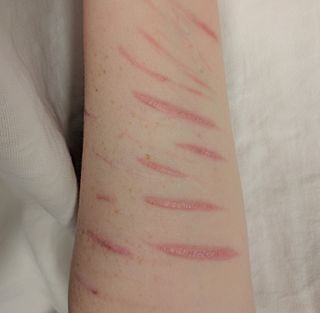Related Research Articles

Borderline personality disorder (BPD), also known as emotionally unstable personality disorder (EUPD), is a personality disorder characterized by a long-term pattern of intense and unstable interpersonal relationships, distorted sense of self, and strong emotional reactions. Those affected often engage in self-harm and other dangerous behaviors, often due to their difficulty with returning their emotional level to a healthy or normal baseline. They may also struggle with a feeling of emptiness, fear of abandonment, and dissociation.

Self-harm is intentional behavior that is considered harmful to oneself. This is most commonly regarded as direct injury of one's own skin tissues usually without a suicidal intention. Other terms such as cutting, self-injury, and self-mutilation have been used for any self-harming behavior regardless of suicidal intent. The most common form of self-harm is using a sharp object to cut the skin. Other forms include scratching, hitting, or burning body parts. While earlier usage included interfering with wound healing, excessive skin-picking, hair-pulling, and the ingestion of toxins, current usage distinguishes these behaviors from self-harm. Likewise, tissue damage from drug abuse or eating disorders is not considered self-harm because it is ordinarily an unintended side-effect but context may be needed as intent for such acts varies.

Psychological pain, mental pain, or emotional pain is an unpleasant feeling of a psychological, non-physical origin. A pioneer in the field of suicidology, Edwin S. Shneidman, described it as "how much you hurt as a human being. It is mental suffering; mental torment." There is no shortage in the many ways psychological pain is referred to, and using a different word usually reflects an emphasis on a particular aspect of mind life. Technical terms include algopsychalia and psychalgia, but it may also be called mental pain, emotional pain, psychic pain, social pain, spiritual or soul pain, or suffering. While these clearly are not equivalent terms, one systematic comparison of theories and models of psychological pain, psychic pain, emotional pain, and suffering concluded that each describe the same profoundly unpleasant feeling. Psychological pain is widely believed to be an inescapable aspect of human existence.
Suicide is the second leading cause of death for people in the United States from the ages of 10 to 56.
Adjustment disorder is a maladaptive response to a psychosocial stressor. It is classified as a mental disorder. The maladaptive response usually involves otherwise normal emotional and behavioral reactions that manifest more intensely than usual, causing marked distress, preoccupation with the stressor and its consequences, and functional impairment.

Suicide prevention is a collection of efforts to reduce the risk of suicide. Suicide is often preventable, and the efforts to prevent it may occur at the individual, relationship, community, and society level. Suicide is a serious public health problem that can have long-lasting effects on individuals, families, and communities. Preventing suicide requires strategies at all levels of society. This includes prevention and protective strategies for individuals, families, and communities. Suicide can be prevented by learning the warning signs, promoting prevention and resilience, and committing to social change.

An estimated 1 million people worldwide die by suicide every year. Globally, suicide ranks among the three leading causes of death among those aged 15 to 44 years. Attempted suicides are up to 20 times more frequent than completed ones.
Suicide intervention is a direct effort to prevent a person or persons from attempting to take their own life or lives intentionally.

Suicidal ideation, or suicidal thoughts, is the thought process of having ideas, or ruminations about the possibility of ending one's own life. It is not a diagnosis but is a symptom of some mental disorders, use of certain psychoactive drugs, and can also occur in response to adverse life events without the presence of a mental disorder.
Suicide risk assessment is a process of estimating the likelihood for a person to attempt or die by suicide. The goal of a thorough risk assessment is to learn about the circumstances of an individual person with regard to suicide, including warning signs, risk factors, and protective factors. Risk for suicide is re-evaluated throughout the course of care to assess the patient's response to personal situational changes and clinical interventions. Accurate and defensible risk assessment requires a clinician to integrate a clinical judgment with the latest evidence-based practice, although accurate prediction of low base rate events, such as suicide, is inherently difficult and prone to false positives.
A suicide crisis, suicidal crisis or potential suicide is a situation in which a person is attempting to kill themselves or is seriously contemplating or planning to do so. It is considered by public safety authorities, medical practice, and emergency services to be a medical emergency, requiring immediate suicide intervention and emergency medical treatment. Suicidal presentations occur when an individual faces an emotional, physical, or social problem they feel they cannot overcome and considers suicide to be a solution. Clinicians usually attempt to re-frame suicidal crises, point out that suicide is not a solution and help the individual identify and solve or tolerate the problems.

Suicide is the act of intentionally causing one's own death. Mental disorders, physical disorders, and substance abuse are risk factors. Some suicides are impulsive acts due to stress, relationship problems, or harassment and bullying. Those who have previously attempted suicide are at a higher risk for future attempts. Effective suicide prevention efforts include limiting access to methods of suicide such as firearms, drugs, and poisons; treating mental disorders and substance abuse; careful media reporting about suicide; and improving economic conditions. Although crisis hotlines are common resources, their effectiveness has not been well studied.

Gender differences in suicide rates have been shown to be significant. There are different rates of suicides and suicidal behavior between males and females. While females more often have suicidal thoughts, males die by suicide more frequently. This discrepancy is also known as the gender paradox in suicide.
A suicide attempt is an act in which an individual tries to die by suicide but survives. While it may be described as a "failed" or "unsuccessful" suicide attempt, mental health professionals discourage the use of these terms as they imply that a suicide resulting in death is a successful or desirable outcome.

Depression, one of the most commonly diagnosed psychiatric disorders, is being diagnosed in increasing numbers in various segments of the population worldwide. Depression in the United States alone affects 17.6 million Americans each year or 1 in 6 people. Depressed patients are at increased risk of type 2 diabetes, cardiovascular disease and suicide. Within the next twenty years depression is expected to become the second leading cause of disability worldwide and the leading cause in high-income nations, including the United States. In approximately 75% of suicides, the individuals had seen a physician within the prior year before their death, 45–66% within the prior month. About a third of those who died by suicide had contact with mental health services in the prior year, a fifth within the preceding month.

Suicide by hanging is the intentional killing of oneself (suicide) via suspension from an anchor-point such as an overhead beam or hook, by a rope or cord or by jumping from a height with a noose around the neck.

Igor Galynker is an American psychiatrist, clinician and researcher. His diverse interests include bipolar disorder, suicide prevention, and the role of family in psychiatric illness. He has published on these topics both in professional journals and in the lay press. Most recently his research has been devoted to describing a suicide-specific clinical state, a phenotype of the Suicide Crisis Syndrome (SCS).
In colleges and universities in the United States, suicide is one of the most common causes of death among students. Each year, approximately 24,000 college students attempt suicide while 1,100 students succeed in their attempt, making suicide the second-leading cause of death among U.S. college students. Roughly 12% of college students report the occurrence of suicide ideation during their first four years in college, with 2.6% percent reporting persistent suicide ideation. 65% of college students reported that they knew someone who has either attempted or died by suicide, showing that the majority of students on college campuses are exposed to suicide or suicidal attempts.
Suicide and trauma is the increased risk of suicide that is caused by psychological trauma.

Suicide cases have remained constant or decreased since the outbreak of the COVID-19 pandemic. According to a study done on twenty-one high and upper-middle-income countries in April–July 2020, the number of suicides has remained static. These results were attributed to a variety of factors, including the composition of mental health support, financial assistance, having families and communities work diligently to care for at-risk individuals, discovering new ways to connect through the use of technology, and having more time spent with family members which aided in the strengthening of their bonds. Despite this, there has been an increase in isolation, fear, stigma, abuse, and economic fallout as a result of COVID-19. Self-reported levels of depression, anxiety, and suicidal thoughts were elevated during the initial stay-at-home periods, according to empirical evidence from several countries, but this does not appear to have translated into an increase in suicides.
References
- ↑ Sims, A; O'Brien, K (1979). "Autokabalesis: An account of mentally ill people who jump from buildings". Medicine, Science, and the Law. 19 (3): 195–8. doi:10.1177/002580247901900310. PMID 459744. S2CID 39917411.
- ↑ Isbister, E.S.; Roberts, J.A. (1992). "Autokabalesis: A study of intentional vertical deceleration injuries". Injury. 23 (2): 119–22. doi:10.1016/0020-1383(92)90046-U. PMID 1572707.
- ↑ Katz, Kalman; Gonen, Noah; Goldberg, Igo; Mizrahi, Joseph; Radwan, Marguerite; Yosipovitch, Zvi (1988). "Injuries in attempted suicide by jumping from a height". Injury. 19 (6): 371–4. doi:10.1016/0020-1383(88)90124-6. PMID 3267637.
- ↑ Abrams, Robert C.; Marzuk, Peter M.; Tardiff, Kenneth; Leon, Andrew C. (2005). "Preference for Fall from Height as a Method of Suicide by Elderly Residents of New York City". American Journal of Public Health. 95 (6): 1000–2. doi:10.2105/AJPH.2004.037861. PMC 1449299 . PMID 15914824.
- ↑ Hahn, MP; Richter, D; Ostermann, PA; Muhr, G (1995). "Verletzungsmuster nach Sturz aus großer Höhe. Eine Analyse von 101 Fällen" [Injury pattern after fall from great height. An analysis of 101 cases]. Der Unfallchirurg (in German). 98 (12): 609–13. PMID 8584940.
- ↑ Joyce, J.; Fleminger, S. (1998). "Suicide attempts by jumping". Psychiatric Bulletin. 22 (7): 424. doi: 10.1192/pb.22.7.424 .